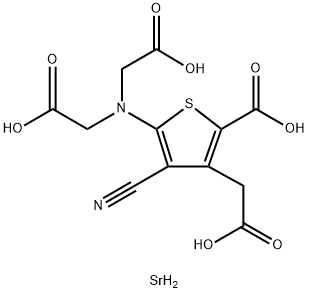| Drug for the treatment of osteoporosis |
Strontium ranelate is a drug for the treatment of osteoporosis with its appearance being white to light yellow powder or crystalline powder. It is odorless and slightly soluble in water but almost insoluble in ethanol and easily soluble in dilute hydrochloric acid. It was first studied and developed by the French Servier Company and had first entered into market in November 2004 in Ireland and entered into market in UK in December of same year. Japan's Fujisawa Pharmaceutical Company has owned the authorization of development, production and marketing right of this product in Japan. It is clinically mainly used for the treatment and prevention of osteoporosis in postmenopausal women with significantly reducing the risk of occurrence of vertebral fractures and hip fractures.
Strontium ranelate has dual pharmacological inhibitory effects of both inhibiting bone absorption and promoting bone formation. On the one hand, in the osteoblast-enriched cells, it can increase the synthesis of collagen and non-collagen proteins and promote the osteoblast-mediated bone formation mediated by osteoblasts through enhancing the proliferation of pre-osteoblast. On the other hand, through decreasing the osteoclast differentiation and reabsorbing activity and further reduction of bone absorption, it achieves the rebalance of bone turnover, further boosting the bone formation.
Strontium ranelate mainly exerts its pharmacological effects through its strontium atoms. Strontium is an alkaline earth metal element which is cognate with calcium and located under the calcium in the element periodic table. Its absorption, distribution, excretion is similar with calcium. After oral administration of 2g, the absolute bioavailability of strontium is 27%. Large doses of strontium cause abnormalities of bone mineral metabolism with low doses of strontium being able to the enhance the pre-osteoblast replication, increasing the number of osteoblasts to stimulate bone formation while reducing the activity of osteoclasts, reducing osteoclast quantity as well as reducing the rate of bone absorption. The results are consistent with the results found in animal and human in vivo studies.
s (OP) is a progressive skeletal disease, characterized by reduced bone mineral density (BMD) and degenerative changes in bone tissue microstructure. It is exhibited as bone fragility and fracture-prone with the latter most commonly happening in the spine, hip and wrist. For women, when after surgical removal of the ovaries or menopause, the body stops producing bone to maintain strong estrogen, thus, primary OP is particularly common in post-menopausal or menopausal women.
There are currently two major kinds of drugs used in the treatment of osteoporosis: one kind includes those drugs that inhibits osteoclast activity and therefore inhibiting bone absorption such as bisphosphonates, estrogen and calcitonin; the second category includes those drugs which promote the osteoblast activity, and thereby stimulating bone formation and there are currently only a product, human recombinant parathyroid hormone 1-34, that has entered into market. It however requires injection with high drug prices.
The above information is edited by the chemicalbook of Dai Xiongfeng. |

 China
China



